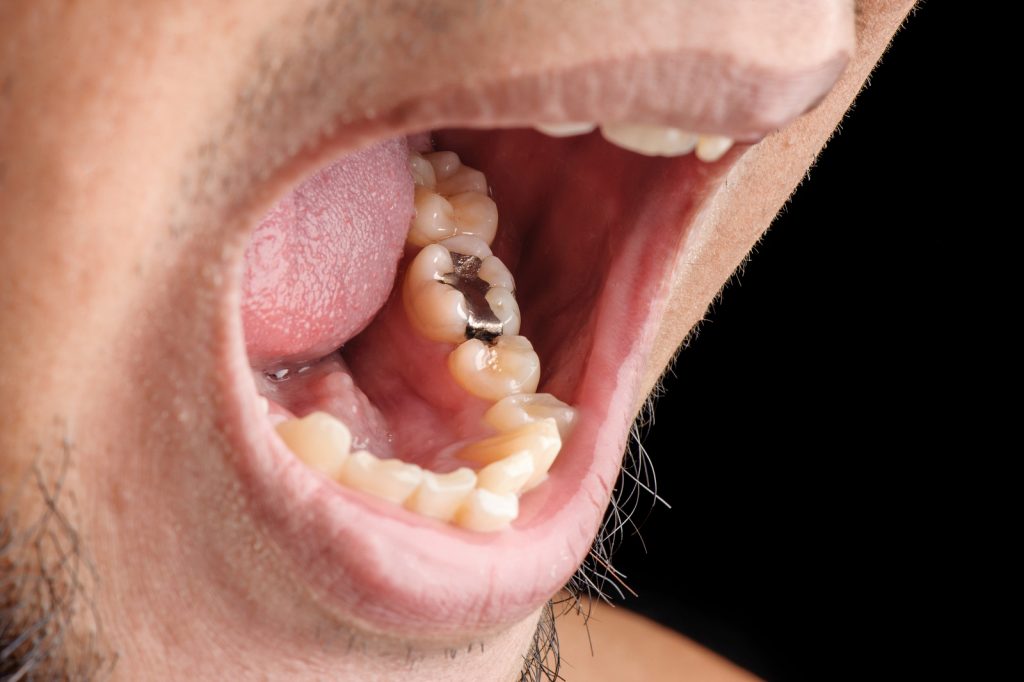What are amalgam fillings?
Amalgam fillings are dental fillings that are made from a mixture of metals, primarily liquid mercury and a powdered alloy composed of silver, tin and copper. Amalgam fillings are also known as silver fillings, silver-coloured fillings, mercury fillings and metal fillings.
Although there are several articles online that claim dental amalgams emit toxic properties (mercury), evidence shows that these levels are very low and the exposure to mercury from amalgam fillings has no harmful effects on patient health.

Can I have amalgam fillings removed?
As the demand for porcelain and non-mercury-based medicine rise, patients who have previously undergone amalgam-based treatment are considering having them removed. Despite the health risks being deemed low by both the British Dental Association (BDA) and the FDA in America, patients now prefer more discreet fillings that merge with the colour of their existing teeth (porcelain fillings).
Removing and replacing amalgam fillings follows a similar process to standard filling replacement procedures, but if your filling is healthy and functioning as it should, your dentist may choose to avoid replacing it. Only when fillings become damaged, loose or have fallen out will they need replacing.
However, you can still book in with your dentist to see what options are available regarding having your amalgam fillings replaced.
Are there any side effects of having amalgam fillings?
The effects of mercury in amalgam fillings is not considered dangerous due to the low levels emitted. If you are allergic to certain metals, however, this risk increases and it’s unlikely that you will be a candidate for amalgam fillings. The associated risks with regards to the metals in amalgam fillings are:
- Silver: at larger doses, silver can cause irritation inside a patient’s mouth. Aside from this, no other side effects are known.
- Copper: when exposed to high levels of copper, you may suffer from liver and/or kidney damage as well as a compromised immune system.
- Tin: inorganic tin (when tin is combined with chemicals such as chlorine, sulfur or oxygen) it can cause nausea and vomiting.
- Zinc: although zinc is an important micronutrient, high doses can cause digestive problems and lead to iron and copper deficiencies.
Replacing amalgam fillings
If your amalgam filling has become loose, damaged or fallen out, you will be able to have it replaced. Porcelain-based fillings and PFM crowns (porcelain-fused-to-metal crowns). The process follows that of a routine filling replacement, wherein your dentist will assess the condition of your old filling and recommend a replacement that suits your tooth’s condition and your personal preferences.
PFM crowns stand for “porcelain-fused-to-metal”, and combine the benefits of metal crowns (durability) with the aesthetic advantages of porcelain crowns.
Do amalgam fillings contain mercury?
Yes, amalgam fillings contain approximately 50% of elemental mercury (by weight). However, despite the negative effects associated with mercury, BDA states:
It’s important to inform your dentist on whether you suffer from allergic reactions to certain metal types, as this may prohibit you from having any metal-based fillings.
Advantages and disadvantages of amalgam fillings
The main advantages of amalgam fillings are:
- Amalgam fillings are typically less expensive than other fillings
- The treatment is often completed in one visit
- Amalgam fillings are very durable and are ideal for back teeth (which exert the most force when biting and chewing)
Disadvantages include:
- Amalgam fillings can cause hot and cold sensitivities within the first few weeks are your mouth gets used to the new filling
- Patients with metal allergies cannot use amalgam fillings as it can cause adverse reactions
- They are not discreet
Amalgam’s association with mercury is another reason people have concerns about their safety. Again, there is nothing to prove that low doses of mercury have any long-term negative health effects.
Are there any alternatives to amalgam fillings?
Composite fillings are a popular alternative to amalgam fillings, as they are designed to match the natural colour of your teeth. These filings are newer and typically more expensive because of their aesthetic benefits. However, they are not as durable as metal-based fillings.
Learn more about composite fillings and their benefits to see whether you’re a candidate for this option.
FAQs
The concern is based on the act that dental amalgam contains and releases low-level amounts of mercury in vapour form. When inhaled in large doses, mercury can have negative long-term effects that could cause:
Damaged motor skills
Heart problems
Numbness
Problems with memory
Reproductive problems (reduced sperm count or decreased fertility)
However, low levels of mercury have been reported to have no negative health effects, as the benefits outweigh the risks.
White fillings’ main benefit is that they’re designed to merge with the natural colour of your teeth. However, they are not as durable as metal-based fillings, including amalgam fillings. As with any filling, it’s durability and lifespan depends on a few factors, including the eating habits of the patient, where the filling is placed (molars at the back of the mouth work harder than front teeth) and how well the patient looks after their oral hygiene.
Can I choose what filling I get?
Both you and your dentist will discuss what filling is most beneficial and appropriate for your needs. If, for example, you would prefer porcelain-based fillings due to their aesthetic properties, this is something you can discuss with your dentist. If you’re allergic to certain metals, then this will likely eliminate you from any metal-based fillings.
In basic terms, mercury is used in amalgam because it’s a flexible and versatile substance, which makes filling gaps, cracks and fissures in teeth easy. Mercury needs to be mixed with an alloy power so that it’s able to be pressed into the tooth. Mercury also hardens very quickly, aiding a fast recovery for the patient.





















